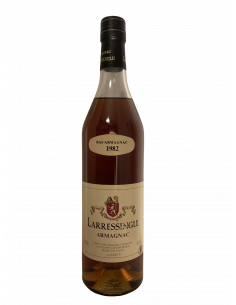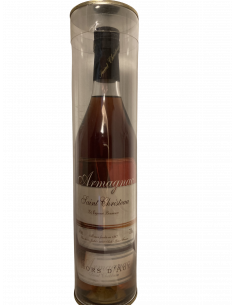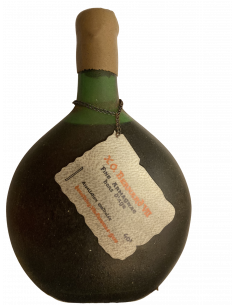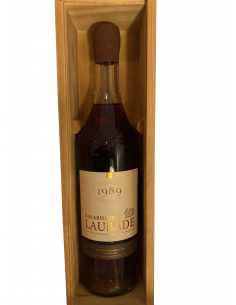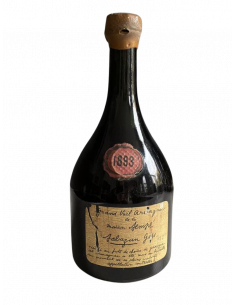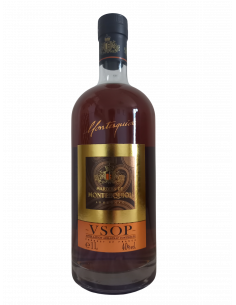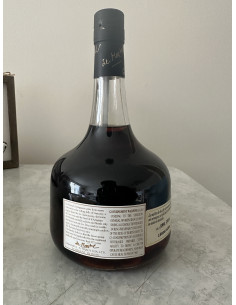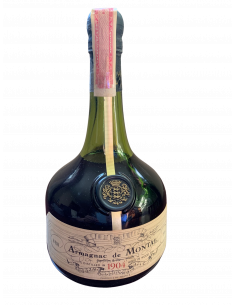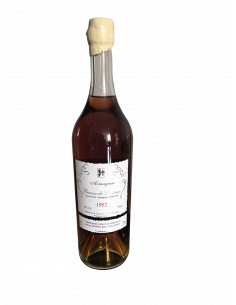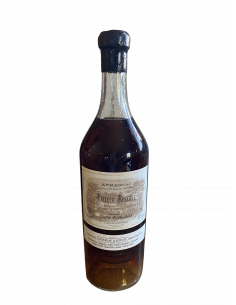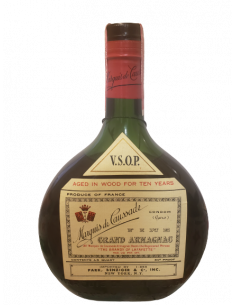Armagnac
All about Armagnac
Armagnac is a type of brandy made in the Armagnac region of France. Armagnac is a type of brandy made from white grapes and is distilled in an alembic still. It is made in the Southwest of France, in the Gascony region of Armagnac. The wines used to produce Armagnac are a blend of at least three varieties of grapes, including Ugni Blanc, Baco, Colombard and Folle Blanche. It is usually aged in oak barrels for a minimum of two years before being bottled.
Armagnac is often compared to the more widely known Cognac. While both are brandies, Cognac is made from a blend of white wines and aged for a minimum of two years in oak barrels, Armagnac is made from a single grape variety and aged for a minimum of three years in oak barrels. This gives Armagnac a more distinctive flavor and a deeper, more complex flavor profile than Cognac.
On our platform cabinet7, you can buy old Armagnac. Old Armagnac can be aged for up to 50 years (or more), developing complex and intense flavors. Vintage Armagnac is a special treat for those who enjoy the finesse of a well-aged spirit that has been crafted with care and precision. Cabinet7 offers a range of vintage Armagnac from the Armagnac region of France. Our selection of vintage Armagnac ranges from 5 years to 50 years old Armagnac (and even older), with a range of flavor profiles to suit all tastes. From light and fruity, to rich and complex, we have a vintage Armagnac to suit every palate. So, if you're looking for a unique and special spirit to enjoy, why not explore our selection of Armagnac on cabinet7?
The three growth areas of Armagnac are Bas-Armagnac, Tenareze and Haut-Armagnac. Bas-Armagnac is the largest of the three areas and produces the most Armagnac. Maybe you've already asked yourself "What is Bas Armagnac" - now you know that it's one of the growth areas. bas Armagnac is characterized by lighter, more delicate flavors and aromas.
Tenareze is the smallest of the three areas, but produces some of the most complex and intense Armagnac. Finally, Haut-Armagnac is the middle ground between the two, producing Armagnac with a balance of fresh, fruity flavors and more robust, complex aromas. Each of these terroirs has its own unique characteristics, which can be discovered by exploring the different styles of Armagnac available from each region.
Should I drink or sell the old Armagnac bottle I inherited?
When you inherit an old Armagnac bottle, it is important to understand that Armagnac is an aged spirit, much like whisky, rum or cognac. This means that it has been aged and matured in a barrel, giving it a unique flavor and complexity. Therefore, it is best to drink it slowly and savor the flavor, rather than chugging it down or trying to make a quick buck by selling it.
Before you make a decision, it is a good idea to research the value of your bottle and explore the possible taste elements of the Armagnac within. This will help you to determine whether you would prefer to savor the taste of the Armagnac or if you would rather sell it for a profit.
As we already mentioned in detail for selling old whisky, it's also always a personal decision.
Determine the value of your old Armagnac here. Based on our extensive database, which we have built up over the last ten years, we can reliably identify all types of limited edition Armagnacs and collector Armagnac bottles. We evaluate the realistic market value of your vintage, rare and old Armagnacs. The value is based on historic and current transactional price data.
What is the best way to sell an old Armagnac bottle?
The best way to sell an old Armagnac bottle is to research the bottle and its value. With this information, you can then list the bottle on online platforms such as cabinet7, or contact local antique dealers and collectors to see if they are interested. You may also want to consider attending local antique markets and flea markets, as these can be great places to find potential buyers.
If you don't have the time or inclination to determine the value of your bottle, we'll be happy to do it for you. Submit your bottle here in order to receive a free appraisal. You can still decide later if you want to put the item on sale.
If you want to learn more about the different ways to sell old Armagnac, you can see a detailed list here.
Armagnac: History, Production and the difference between Armagnac and Cognac
Armagnac is one of the oldest spirits in the world - maybe even the oldest wine spirit. The first written evidence of the drink was noted in 1310, scribed in Latin in the pages of a book entitled To Keep Your Health and Stay on Top Form. It was first produced in the south-west of France, in the region of Gascony, which is now part of the department of Gers. This area is one of the few remaining parts of France where the local language, Gascon, is still spoken.
Armagnac is produced from a variety of grapes, but the most common are Ugni Blanc, Folle Blanche, and Colombard. The grapes are harvested and fermented, and then distilled in either a pot still or a continuous still.
The distillate is then aged in oak barrels, usually for at least 3 years, although some producers will age their Armagnac for upwards of 20 years (and more). During the aging process, the Armagnac develops a range of flavors and aromas, from fruity and floral to more savory and mature notes.
We can track more and more interest in Armagnac which includes of course also old Armagnacs for collectors.
Armagnac is often served neat, although it can also be used in cocktails, or as an accompaniment to desserts. It is also known for its medicinal properties, and is sometimes used to help with digestive issues.
Cognac vs. Armagnac
The key difference between Cognac and Armagnac is the type of grapes used to make the spirit. Cognac is made from white grapes such as Ugni Blanc and Folle Blanche, while Armagnac is made from a mix of red, white, and black grapes, such as Ugni Blanc, Folle Blanche, and Colombard.
Armagnac can also be produced from:
- Plant de Graisse
- Meslier Saint François
- Clairette de Gascogne
- Jurançon Blanc
- Mauzac Blanc
- Mauzac Rosé
Most importantly, Armagnac is only distilled a single time while Cognac is double distilled.
How to make Armagnac
It’s not only about the distillation process. Making Armagnac is a lengthy process that requires a lot of patience and attention to detail. The first step is to harvest the grapes, which can be done either by hand or machine. The grapes are then fermented and distilled. The distillate is then aged in oak barrels for at least 3 years. During the aging process, the Armagnac continues to develop layers of flavor and aroma. Once the aging process is complete it’s common for Armagnac to be transferred from the barrel into Dame Jeanne/Demijohn glass bottles, or even steel tanks.
Different Types of Armagnac
Armagnac is classified by age and quality, with the youngest being a VS (Very Special) and the oldest being an XO (Extra Old). There are also other designations, such as Hors d'Age, which is over 20 years old, and Vintage Armagnac, which is made from only one harvest year.
The classifications and meanings for Armagnac are:
- VS or ***: Has been aged for a minimum of one year
- VSOP: Aged for a minimum of four years
- Napoleon & XO: Aged for a minimum of six years
- Hors d’Age: Aged for a minimum of 10 years
- Vintage: Aged for a minimum of 10 years and will have the year of the harvest displayed on the label
How to serve Armagnac
Armagnac is often served neat, although it can also be used in cocktails, or as an accompaniment to desserts. It can be served at room temperature or slightly chilled, depending on preference.
Armagnac is often served neat, although it can also be used in cocktails, or as an accompaniment to desserts. When drinking Armagnac neat, it is best to let it sit in the glass for a few minutes (or even warm it up in your hands) before sipping. This highlights the aroma even more clearly. In most cases, we personally prefer an Armagnac neat. You can also enjoy Armagnac with a splash of water or slightly chilled, which can help to open up the flavor of the spirit - but this is very often a personal matter. Finally, you can also enjoy Armagnac in a variety of cocktails, such as an Old Fashioned, an Armagnac Sour, or a classic Sidecar. They are all delicious - try them!
Armagnac is a type of brandy made in the Armagnac region of Gascony, France. It is distilled from a variety of grapes and afterwards aged in oak barrels, giving it a distinct flavor and aroma. It is often considered to be the oldest type of brandy in the world at least the oldest wine spirit, with some production methods dating back to the 14th century.
Armagnac is made from a variety of grapes, including Folle Blanche, Ugni Blanc, and Colombard.
Armagnac does not go bad, but it can become oxidized over time. It is best to store Armagnac in a cool, dark place and away from direct sunlight. If stored properly, Armagnac can last for many decades.
Old Armagnac can be purchased from specialty stores and online retailers (lie our platform cabient7). The prices for older Armagnac will vary depending on age, brand, and other factors.
Bas Armagnac is one of the growth areas and is is usually considered to be the highest quality and most sought-after Armagnac.
Well, that’s something that can only be decided by you. Both spirits are made from grapes and have distinct flavor profiles. Cognac is typically considered to be smoother and more approachable than Armagnac, which has a bolder, more complex flavor. Ultimately, it comes down to your personal preference.


